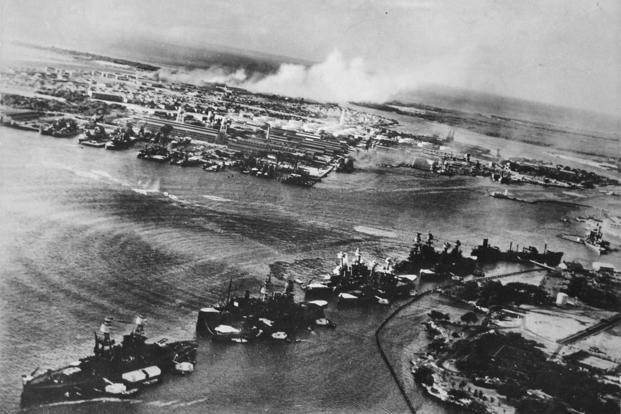The Japanese attacked pearl Harbor on December 7th, 1941, marking the US entrance into WWII.
Prior to WWII, japan expanded it’s territories by annexing Korea and setting up a puppet-state of Manchukuo in northern China, and proceeded to invade the rest of China killing as many as 300,000 in the heinous Nanking massacre. While being unhappy with Japan’s actions, the League of Nations did nothing to hinder Japanese expansion. After joining the Axis powers in WWII, Japan occupied parts of southern Indochina to gain more natural resources, triggering an embargo on trade from the United states. This presented a problem for the Japanese, who relied on American trade to fuel their war effort (55.4% of imports to Japan came from the US prior to WWII).
Negotiations with Japan about ceasing its expansion were leading nowhere, and the United States was suspecting an attack on the Philippines. However, Japan dispatched 6 aircraft carriers, 2 battleships, 3 cruisers, and 11 destroyers towards Hawaii with complete radio silence. 275 miles away from O’ahu, 360 planes were launched towards Pearl Harbor.

The fleet was first seen at 7:00am, and was mistaken for an incoming American fleet of B-17s that were due that morning. At 7:48am, Fort Island finally sent out a radio report stating “AIRRAID ON PEARL HARBOR X THIS IS NO DRILL”

The first Japanese attack consisted of 200 dive-bombers, torpedo planes, and fighters. Targeting the airfields, where planes were tightly parked wingtip to wingtip, Japanese forced destroyed more than 180 aircraft, with only 6 being able to take off to fend off the attack. The lines of undermanned battleships moored at Battleship Row were an easy target as well, with most of the damage happening in the first 30 minutes. USS Arizona blew up after her magazine was hit; USS West Virginia sank at the bottom of the harbour; USS Oklahoma rolled over completely; USS Utah was sunk; USS Califorina, the flagship of the pacific fleet, was abandoned as it slowly submerged in the shallow water.




At 8:50, the second Japanese fleet arrived, less successful than the first but doing much damage. USS Pennsylvania was set ablaze, and USS Shaw was split by an explosion, and many destroyers were reduced to wrecks. The Japanese withdrew victorious at 9:00am, loosing only about 100 men, without being attacked on their retreat.
On December 8th, Congress declared war on Japan. The attack led to reorganizations and criticism of the American military forces, and brought first American troops to battle agains the Axis powers. The attack had an impact on the Manhatten project as well, officially moving the S-1 (precursor to the Manhatten Project) from the research to the development phase. Pearl Harbor served as one of the justifications for dropping atomic bombs on Hiroshima and Nagasaki, with President Truman stating “The Japanese began the war from the air at Pearl Harbor. They have been repaid many fold.”
Sources:
I found your article very interesting, especially how the American forces in Pearl Harbor were left devastated, and how this led Congress to declare war on Japan promptly after. After some further research, I learned that the Japanese destroyed nearly 300 aircraft and killed around 2,400 Americans at Pearl Harbor. Despite this loss, however, the U.S. struck back at Japan in June of 1942, 6 months after Pearl Harbor. In the Battle of Midway, a major victory was achieved, thus turning the tide of the war within the Pacific in favor of the United States.
ReplyDeletehttps://www.history.com/news/why-did-japan-attack-pearl-harbor
https://www.history.com/topics/world-war-ii/battle-of-midway
Your post is really well written and has a lot of interesting information! I like how you made the connection to the Manhattan Project and the bombing of Hiroshima and Nagasaki. It demonstrates how important the attack on Pearl Harbor was not only in bringing the U.S. into the war but also on their approach to war.
ReplyDeleteI found that your post was very informative on the main reason the US decided to join the war. I liked how you had lots of detail through the post, which really helped me understand the size of the catastrophe and how quick the attack happened. With troops still on board the battleships with over 2,000 deaths, their were still eyewitness of the attack, describing the explosions ripping "the ship's sides open like a tin can". Some were able to jump and escape, but still suffered many injuries.
ReplyDeletehttp://www.eyewitnesstohistory.com/pearl.htm